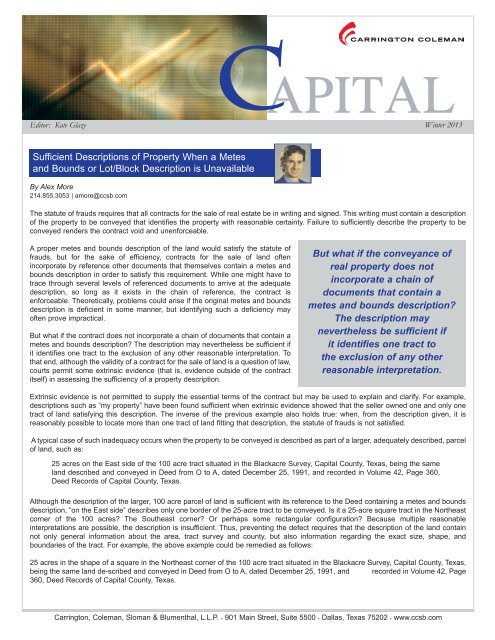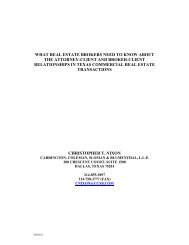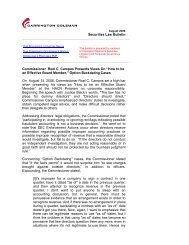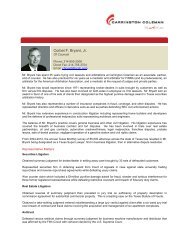Sufficient Descriptions of Property When a Metes and Bounds or Lot ...
Sufficient Descriptions of Property When a Metes and Bounds or Lot ...
Sufficient Descriptions of Property When a Metes and Bounds or Lot ...
You also want an ePaper? Increase the reach of your titles
YUMPU automatically turns print PDFs into web optimized ePapers that Google loves.
cAPITAL<br />
Edit<strong>or</strong>: Kate Glaze Winter 2013<br />
<strong>Sufficient</strong> <strong>Descriptions</strong> <strong>of</strong> <strong>Property</strong> <strong>When</strong> a <strong>Metes</strong><br />
<strong>and</strong> <strong>Bounds</strong> <strong>or</strong> <strong>Lot</strong>/Block Description is Unavailable<br />
By Alex M<strong>or</strong>e<br />
214.855.3053 | am<strong>or</strong>e@ccsb.com<br />
The statute <strong>of</strong> frauds requires that all contracts f<strong>or</strong> the sale <strong>of</strong> real estate be in writing <strong>and</strong> signed. This writing must contain a description<br />
<strong>of</strong> the property to be conveyed that identifies the property with reasonable certainty. Failure to sufficiently describe the property to be<br />
conveyed renders the contract void <strong>and</strong> unenf<strong>or</strong>ceable.<br />
A proper metes <strong>and</strong> bounds description <strong>of</strong> the l<strong>and</strong> would satisfy the statute <strong>of</strong><br />
frauds, but f<strong>or</strong> the sake <strong>of</strong> efficiency, contracts f<strong>or</strong> the sale <strong>of</strong> l<strong>and</strong> <strong>of</strong>ten<br />
inc<strong>or</strong>p<strong>or</strong>ate by reference other documents that themselves contain a metes <strong>and</strong><br />
bounds description in <strong>or</strong>der to satisfy this requirement. While one might have to<br />
trace through several levels <strong>of</strong> referenced documents to arrive at the adequate<br />
description, so long as it exists in the chain <strong>of</strong> reference, the contract is<br />
enf<strong>or</strong>ceable. The<strong>or</strong>etically, problems could arise if the <strong>or</strong>iginal metes <strong>and</strong> bounds<br />
description is deficient in some manner, but identifying such a deficiency may<br />
<strong>of</strong>ten prove impractical.<br />
But what if the contract does not inc<strong>or</strong>p<strong>or</strong>ate a chain <strong>of</strong> documents that contain a<br />
metes <strong>and</strong> bounds description The description may nevertheless be sufficient if<br />
it identifies one tract to the exclusion <strong>of</strong> any other reasonable interpretation. To<br />
that end, although the validity <strong>of</strong> a contract f<strong>or</strong> the sale <strong>of</strong> l<strong>and</strong> is a question <strong>of</strong> law,<br />
courts permit some extrinsic evidence (that is, evidence outside <strong>of</strong> the contract<br />
itself) in assessing the sufficiency <strong>of</strong> a property description.<br />
But what if the conveyance <strong>of</strong><br />
real property does not<br />
inc<strong>or</strong>p<strong>or</strong>ate a chain <strong>of</strong><br />
documents that contain a<br />
metes <strong>and</strong> bounds description<br />
The description may<br />
nevertheless be sufficient if<br />
it identifies one tract to<br />
the exclusion <strong>of</strong> any other<br />
reasonable interpretation.<br />
Extrinsic evidence is not permitted to supply the essential terms <strong>of</strong> the contract but may be used to explain <strong>and</strong> clarify. F<strong>or</strong> example,<br />
descriptions such as “my property” have been found sufficient when extrinsic evidence showed that the seller owned one <strong>and</strong> only one<br />
tract <strong>of</strong> l<strong>and</strong> satisfying this description. The inverse <strong>of</strong> the previous example also holds true: when, from the description given, it is<br />
reasonably possible to locate m<strong>or</strong>e than one tract <strong>of</strong> l<strong>and</strong> fitting that description, the statute <strong>of</strong> frauds is not satisfied.<br />
A typical case <strong>of</strong> such inadequacy occurs when the property to be conveyed is described as part <strong>of</strong> a larger, adequately described, parcel<br />
<strong>of</strong> l<strong>and</strong>, such as:<br />
25 acres on the East side <strong>of</strong> the 100 acre tract situated in the Blackacre Survey, Capital County, Texas, being the same<br />
l<strong>and</strong> described <strong>and</strong> conveyed in Deed from O to A, dated December 25, 1991, <strong>and</strong> rec<strong>or</strong>ded in Volume 42, Page 360,<br />
Deed Rec<strong>or</strong>ds <strong>of</strong> Capital County, Texas.<br />
Although the description <strong>of</strong> the larger, 100 acre parcel <strong>of</strong> l<strong>and</strong> is sufficient with its reference to the Deed containing a metes <strong>and</strong> bounds<br />
description, “on the East side” describes only one b<strong>or</strong>der <strong>of</strong> the 25-acre tract to be conveyed. Is it a 25-acre square tract in the N<strong>or</strong>theast<br />
c<strong>or</strong>ner <strong>of</strong> the 100 acres The Southeast c<strong>or</strong>ner Or perhaps some rectangular configuration Because multiple reasonable<br />
interpretations are possible, the description is insufficient. Thus, preventing the defect requires that the description <strong>of</strong> the l<strong>and</strong> contain<br />
not only general inf<strong>or</strong>mation about the area, tract survey <strong>and</strong> county, but also inf<strong>or</strong>mation regarding the exact size, shape, <strong>and</strong><br />
boundaries <strong>of</strong> the tract. F<strong>or</strong> example, the above example could be remedied as follows:<br />
25 acres in the shape <strong>of</strong> a square in the N<strong>or</strong>theast c<strong>or</strong>ner <strong>of</strong> the 100 acre tract situated in the Blackacre Survey, Capital County, Texas,<br />
being the same l<strong>and</strong> de-scribed <strong>and</strong> conveyed in Deed from O to A, dated December 25, 1991, <strong>and</strong> rec<strong>or</strong>ded in Volume 42, Page<br />
360, Deed Rec<strong>or</strong>ds <strong>of</strong> Capital County, Texas.<br />
Carrington, Coleman, Sloman & Blumenthal, L.L.P. • 901 Main Street, Suite 5500 • Dallas, Texas 75202 • www.ccsb.com
Capital - Winter 2013<br />
Another common issue is whether street addresses are sufficient descriptions. The same principles apply. Where the address reasonably<br />
describes m<strong>or</strong>e than one piece <strong>of</strong> property—such as “123 Abacus,” when there exists 123 Abacus St., 123 Abacus Ln., <strong>and</strong> 123 Abacus<br />
Ct.—the description is insufficient. On the other h<strong>and</strong>, complete addresses that unambiguously identify one <strong>and</strong> only one tract <strong>of</strong> l<strong>and</strong><br />
have been found sufficient.<br />
In litigation on this issue, courts have permitted expert testimony on the sufficiency <strong>of</strong> property descriptions following the principle that if<br />
enough appears in a description so that a person familiar with the area can locate the premises with reasonable certainty, it is sufficient<br />
to satisfy the statute <strong>of</strong> frauds. As discussed above, reasonable certainty in practice means identifying one tract to the exclusion <strong>of</strong> all<br />
other reasonable alternatives. Theref<strong>or</strong>e, while one expert might testify that only one tract <strong>of</strong> l<strong>and</strong> is reasonably identifiable from the<br />
description at issue, a court could still find the description insufficient if an opposing expert credibly testifies that other tracts can be<br />
reasonably ascertained from the description.<br />
In <strong>or</strong>der to ensure that descriptions <strong>of</strong> property in contracts f<strong>or</strong> the sale <strong>of</strong> l<strong>and</strong> satisfy the statute <strong>of</strong> frauds, then, one should ideally<br />
inc<strong>or</strong>p<strong>or</strong>ate by reference a document, such as a rec<strong>or</strong>ded deed, that contains within it a proper metes <strong>and</strong> bounds description <strong>of</strong> the<br />
tract, as well as identification <strong>of</strong> the area, survey <strong>and</strong> county. <strong>When</strong> selling a piece <strong>of</strong> property that is part <strong>of</strong> a larger tract, one must make<br />
sure to avoid the pitfall <strong>of</strong> leaving the shape, size, <strong>and</strong> boundaries <strong>of</strong> that part undefined. This can be remedied by describing the specific<br />
shape, size, <strong>and</strong> boundaries <strong>of</strong> the tract to be conveyed in the contract, <strong>or</strong> by attaching <strong>or</strong> inc<strong>or</strong>p<strong>or</strong>ating by reference a plat that defines<br />
all <strong>of</strong> the boundaries. Retaining a pr<strong>of</strong>essional l<strong>and</strong> survey<strong>or</strong> to create <strong>or</strong> review the plat <strong>of</strong> the tract to be conveyed can provide an added<br />
layer <strong>of</strong> protection, ensuring that the plat c<strong>or</strong>rectly defines the property.<br />
Page 2<br />
Carrington, Coleman, Sloman & Blumenthal, L.L.P. • 901 Main Street, Suite 5500 • Dallas, Texas 75202 • www.ccsb.com





